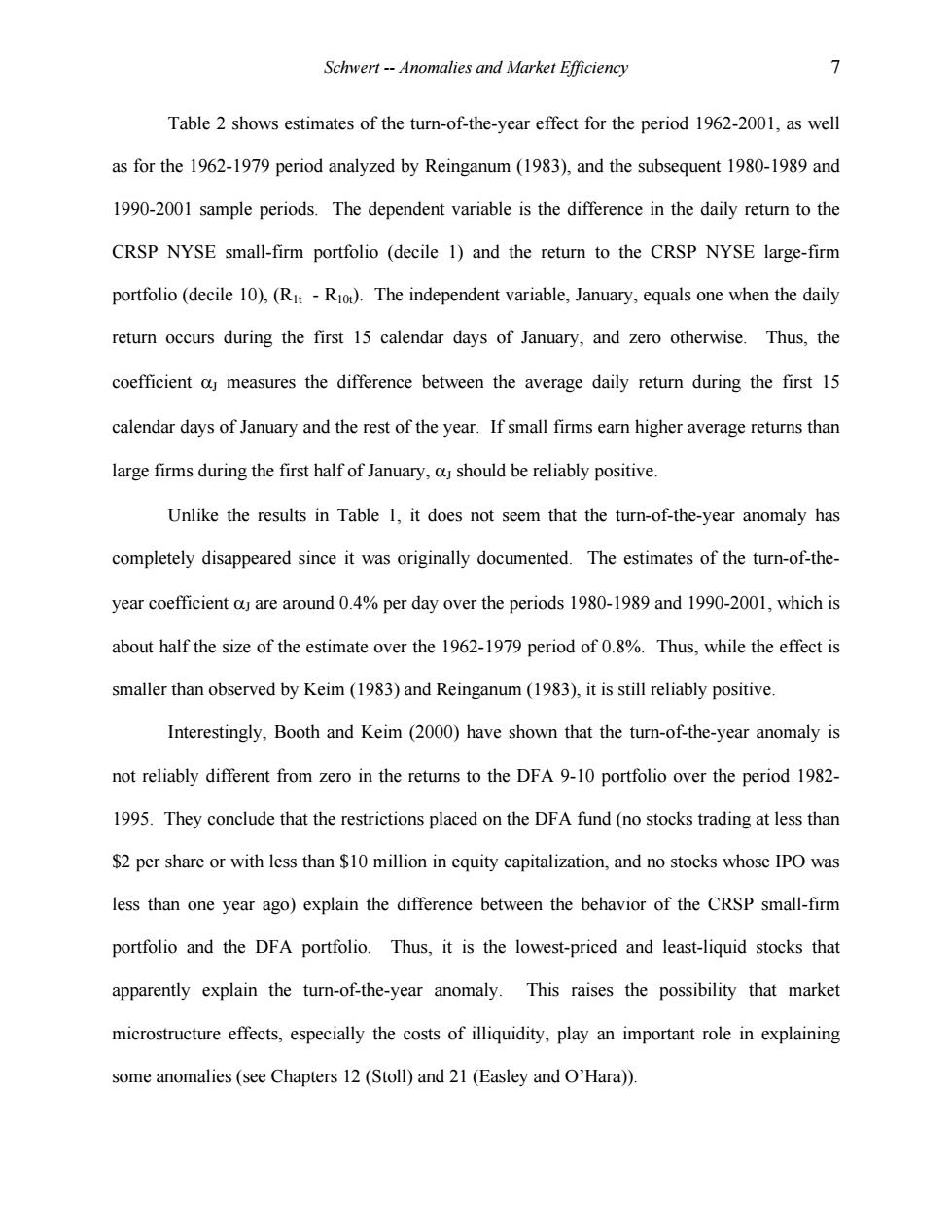正在加载图片...

Schwert--Anomalies and Market Efficiency > Table 2 shows estimates of the turn-of-the-year effect for the period 1962-2001,as well as for the 1962-1979 period analyzed by Reinganum(1983),and the subsequent 1980-1989 and 1990-2001 sample periods.The dependent variable is the difference in the daily return to the CRSP NYSE small-firm portfolio (decile 1)and the return to the CRSP NYSE large-firm portfolio(decile 10),(RIt-Riot).The independent variable,January,equals one when the daily return occurs during the first 15 calendar days of January,and zero otherwise.Thus,the coefficient aj measures the difference between the average daily return during the first 15 calendar days of January and the rest of the year.If small firms earn higher average returns than large firms during the first half of January,a should be reliably positive. Unlike the results in Table 1,it does not seem that the turn-of-the-year anomaly has completely disappeared since it was originally documented.The estimates of the turn-of-the- year coefficient au are around 0.4%per day over the periods 1980-1989 and 1990-2001,which is about half the size of the estimate over the 1962-1979 period of 0.8%.Thus,while the effect is smaller than observed by Keim(1983)and Reinganum(1983),it is still reliably positive. Interestingly,Booth and Keim (2000)have shown that the turn-of-the-year anomaly is not reliably different from zero in the returns to the DFA 9-10 portfolio over the period 1982- 1995.They conclude that the restrictions placed on the DFA fund(no stocks trading at less than $2 per share or with less than $10 million in equity capitalization,and no stocks whose IPO was less than one year ago)explain the difference between the behavior of the CRSP small-firm portfolio and the DFA portfolio.Thus,it is the lowest-priced and least-liquid stocks that apparently explain the turn-of-the-year anomaly.This raises the possibility that market microstructure effects,especially the costs of illiquidity,play an important role in explaining some anomalies(see Chapters 12(Stoll)and 21 (Easley and O'Hara)).Schwert -- Anomalies and Market Efficiency 7 Table 2 shows estimates of the turn-of-the-year effect for the period 1962-2001, as well as for the 1962-1979 period analyzed by Reinganum (1983), and the subsequent 1980-1989 and 1990-2001 sample periods. The dependent variable is the difference in the daily return to the CRSP NYSE small-firm portfolio (decile 1) and the return to the CRSP NYSE large-firm portfolio (decile 10), (R1t - R10t). The independent variable, January, equals one when the daily return occurs during the first 15 calendar days of January, and zero otherwise. Thus, the coefficient aJ measures the difference between the average daily return during the first 15 calendar days of January and the rest of the year. If small firms earn higher average returns than large firms during the first half of January, aJ should be reliably positive. Unlike the results in Table 1, it does not seem that the turn-of-the-year anomaly has completely disappeared since it was originally documented. The estimates of the turn-of-theyear coefficient aJ are around 0.4% per day over the periods 1980-1989 and 1990-2001, which is about half the size of the estimate over the 1962-1979 period of 0.8%. Thus, while the effect is smaller than observed by Keim (1983) and Reinganum (1983), it is still reliably positive. Interestingly, Booth and Keim (2000) have shown that the turn-of-the-year anomaly is not reliably different from zero in the returns to the DFA 9-10 portfolio over the period 1982- 1995. They conclude that the restrictions placed on the DFA fund (no stocks trading at less than $2 per share or with less than $10 million in equity capitalization, and no stocks whose IPO was less than one year ago) explain the difference between the behavior of the CRSP small-firm portfolio and the DFA portfolio. Thus, it is the lowest-priced and least-liquid stocks that apparently explain the turn-of-the-year anomaly. This raises the possibility that market microstructure effects, especially the costs of illiquidity, play an important role in explaining some anomalies (see Chapters 12 (Stoll) and 21 (Easley and O’Hara))